
Ask Chris #50: The Next Best Batman Stories
Here at ComicsAlliance, we value our readership and are always open to what the masses of Internet readers have to say. That's every week, Senior Writer Chris Sims puts his comics culture knowledge to the test as he responds to your reader questions!

Q: I'm itching for some good, new-to-me Batman reading. Asking for the top ten greatest Batman stories, I think will give us the famous greats that most of us have probably read by now. So I want to ask about the next ten. What are the greatest Batman stories ranked eleven through twenty? -- Paul, via email
A: I've actually gotten a lot of requests for a list of good "deep cuts" for Batman lately, and while it's a tricky proposition to figure out which great stories are the ones that don't get talked about as often as the ol' standards, it's not like Batman suddenly stops being good after you read your Year Ones and Mad Loves and R.I.P.s and Killing Jokes and all manner of various Nights of the Beast. There are literally thousands of Batman stories out there, and even more if you're not limited to just the comics, and as you might expect, I think an awful lot of 'em are worth checking out.
And considering it's my 50th installment of "Ask Chris," I'm just glad you didn't ask for eleven through fifty. After all, I have to sleep some time.So with that said -- and with a little brainstorming help from ComicsAlliance's own David Uzumeri, a pretty solid Batmanologist in his own right, to help narrow down the list, here are my picks for that rarely-seen second half of the countdown!
20: Batman: Son of the Demon (1987)
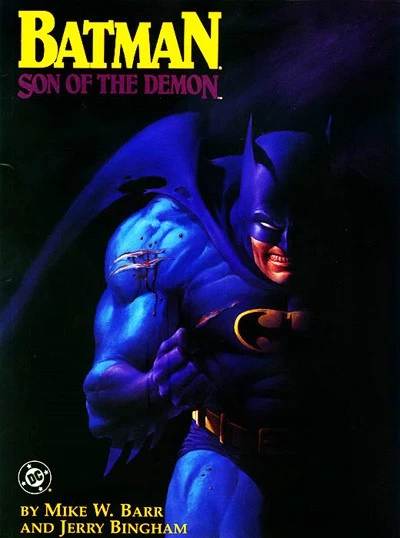
Mike W. Barr and Jerry Bingham's Son of the Demon isn't exactly an obscure title -- especially in the years since Grant Morrison used it as the extremely loose basis for "Batman & Son" -- but it rarely gets mentioned at the top of anyone's list, and usually gets overshadowed by some of Barr's other work on Batman. Don't get me wrong, there's no shame in being outranked by "Fear For Sale," but Son of the Demon is a darn good read.
In a lot of ways, it's like the '80s Action Movie version of Batman -- and I mean that in a good way. There's world travel, big fights in exotic locations with an army of gun-toting mercenaries, and of course, the alluring daughter of an enemy that Batman has to team up with because this time, he's out for revenge!

I'm pretty sure Batman even employs the skill of gymnastics and the kill of karate at some point.
More famously, of course, the story also involves Batman, Talia, and their child. In Morrison's version -- which isn't so much a retcon as a semi-un-retcon, but that's super-hero comics for you -- there was a "eugenics experiment" involved, but here, it's just straight up the product of Batman at his most shirtless, and it lends itself to a very interesting look at the kind of relationship that Batman would be able to have with Talia.
19: "Blood Secrets" - Detective Comics Annual #2 (1989)

I'm not gonna lie, folks: I bought this one a few years back because a) I really like Mark Waid's work as a writer, particularly the run on Flash that saw him frequently co-writing with Brian Augustyn, and b) I really, really wanted to see Batman just straight up wreck a bunch of racists. Oddly enough, despite the promise of the cover, that's actually not what this one's about. Not exactly, anyway.
That's certainly an element to it; the story is related by Batman to an unknown listener who isn't revealed until the final page, detailing an adventure he had during the years he traveled around the world training to become Batman. In this case, his travels bring him to Huntsville, Alabama to learn the art of detection from Harvey Harris. This in turn finds him investigating a series of murders linked to a hate crime that took place 40 years earlier, as the men involved are turning up as the victims of an unknown killer.
It's a compelling mystery story with a twist ending, but the real story lies in Waid and Augustyn's examination of the Batman's morality.
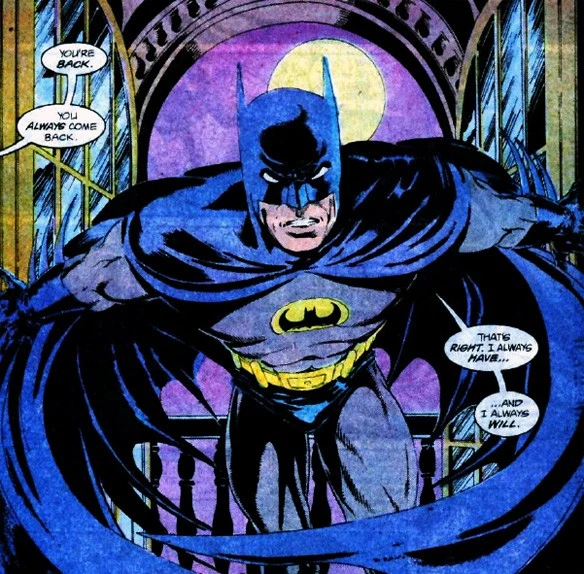
It's not just about solving a crime, but rather the precision with which he has to act, the level of detachment that he has to achieve, and how much of his motivation comes from vengeance and just how dedicated he is to punishing those he deems guilty. And as you might expect, those are things I'm pretty interested in.
18: Batman: Ego (2000)

Considering that it was written and drawn by Darwyn Cooke, I'm always surprised that this one doesn't get talked about more. I remember it being something of a sleeper hit back when it came out, as it was one of the first things Cooke had done in comics, well before more high profile work like New Frontier.
Either way, it's awesome. It's set up as a psychological drama that examines the dichotomy between Bruce Wayne and Batman through an extended sequence where they argue with each other about whether or not "they" should do the world a favor and kill the Joker. And as you might expect from the fact that it's by Cooke, it's absolutely beautiful.

I've talked about the conflict between the different sides of Batman's identity before in this very column, but Cooke's examination is every bit as smart as it is well-drawn. He spends a lot of time examining the roots of Batman's morality, and delves into just what the idea of Batman means, not only to criminals and super-villains but to the people of Gotham City and even what it means to Bruce Wayne himself. In the end, there's a reconciliation -- as there should be -- and while that's a foregone conclusion that's necessary for the character, the journey to it is one of the best character studies in comics.
Unlike a lot of the stories on this list, Ego actually has been collected in a nice volume that also contains Cooke's fantastic Catwoman story, Selina's Big Score, and a handful of short pieces he did with guys like Paul Grist and Tim Sale. If you don't own it, you should.
17: Batman and the Monster Men/ Batman and the Mad Monk (2006)
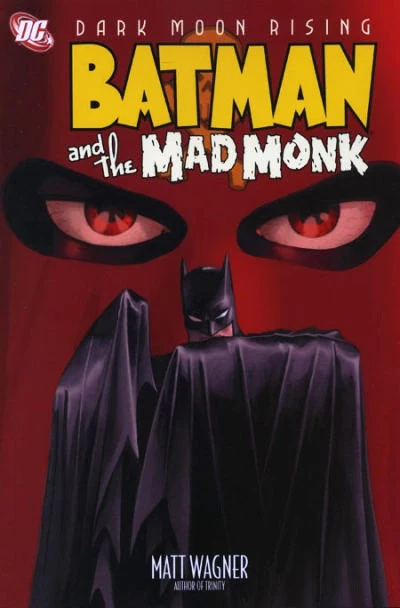
Speaking of excellent creators who have done underrated work on Batman, we have these two. Since Frank Miller dropped his definitive origin story for Batman 25 years ago, there have been dozens -- maybe hundreds -- of stories set in the "Year One" era, and very few of them even come close to being as good as Matt Wagner's two miniseries.
Rather than telling a new story of Batman's rookie season (which can certainly be awesome, as Morrison and Janson's Batman: Gothic proves), Wagner instead went back to the actual year one to tell modern versions of two of Batman's earliest adventures, and the results are incredible.

Much like Ed Brubaker and Doug Manhke did when they retold the first Joker story in Batman: The Man Who Laughs (which is also a darn good comci), Wagner manages to update the story while still preserving the elements that define it as a pulp adventure: Mad scientists creating hulking monster men and a vampire with a house laden with deathtraps. Wagner even manages to do a scene of Batman being vexed by a slowly closing set of walls with spikes sticking out of them and still makes it seem fresh and adventurous.
16: Batman: Death and the Maidens (2003)

By all rights, Greg Rucka and Klaus Janson's Death and the Maidens should've been the last Ra's al-Ghul story. Unfortunately, as evidenced by the mystifying existence of the pretty terrible Resurrection of Ra's al-Ghul from a couple years ago, that didn't exactly work out.
But that doesn't mean it's not a great comic. It's essentially the capstone of what Rucka did in his tenure as the writer of Detective Comics, delving into a piece of al-Ghul's history while simultaneously setting him up for his demise, which also involves him bribing the location of the last Lazarus Pit out of Batman by giving him an alchemical solution that will allow him to see the spirits of his parents.
It's that last bit that makes the middle section of the story so interetsing, as Batman is put into the unique position of having to justify the choices he's made with his life to the people who may have inspired him, but never really wanted to see their son become a masked vigilante dressed like Dracula. Plus, you get to see Martha Wayne straight up slap her son in the face for being disrespectful.
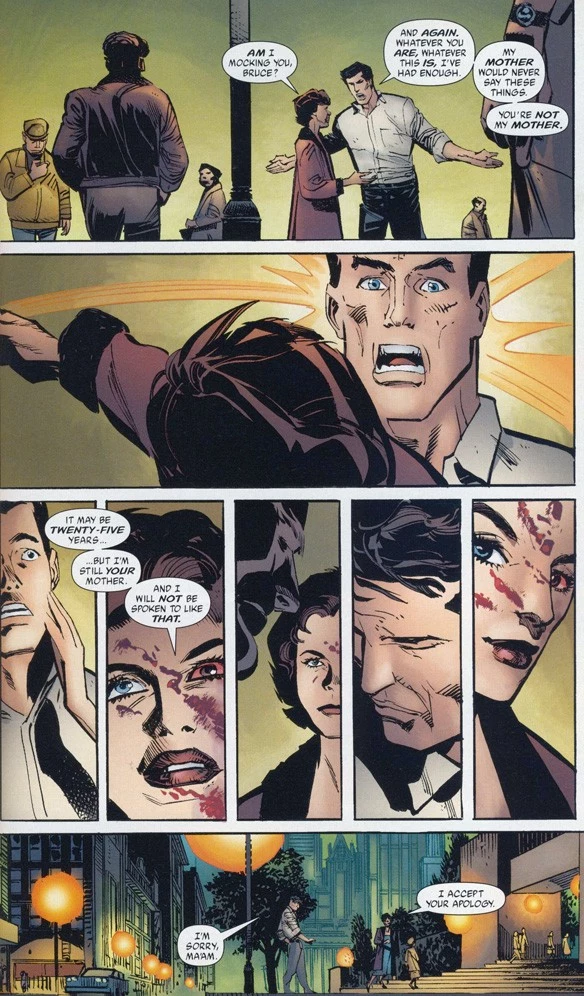
That's right, y'all. Martha Wayne is hardcore.
The only thing that isn't good about this story is how much it brings to the table that is then completely ignored in what might be the biggest waste of potential in the history of the Batman franchise. In their nine issues, Rucka and Janson introduce Nyssa Raatko, the successor to the title of "Ra's al-Ghul," who could have added an entirely new spin on things, but was instead killed off-panel in an issue of Robin, of all things. Truly ridiculous, but that doesn't make this story any worse.
15: "Dead Reckoning" - Detective Comics #777 - 782 (2003)

Another great artifact from the highly underrated Brubaker/Rucka era on the Batman titles is this one, a grand, sweeping murder mystery involving a conspiracy among all of Batman's major villains that focuses on Two-Face and answers the question of what Hush would be like if it were actually any good. Which, considering that both stories were going on at the same time, is pretty hilarious.
The actual story, however, is dead serious, absolutely brutal and meticulously plotted, to the point where it brings back a character that originally appeared 510 issues before in 1943, but done in such a way that it requires no prior knowledge to enjoy.
For reasons that I can't even begin to understand, this story -- and most of Ed Brubaker's run on the Batman books -- has never been collected in paperback, but it's not hard to track down and definitely worth doing so.
#14. The Batman Adventures v.2 #1 - 17 (2003)
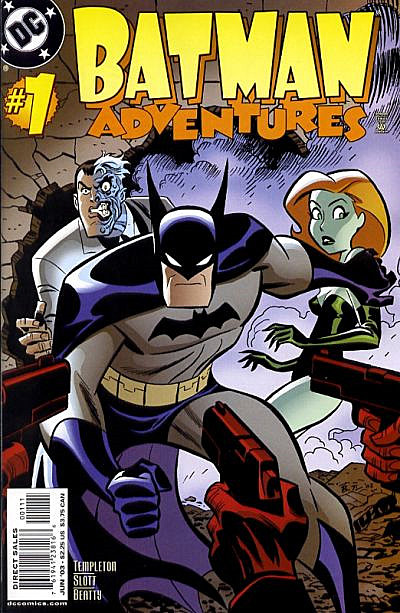
A few years after Batman: The Animated Series finally ended, someone at DC had the brilliant idea to give that version of Batman one final send-off, and the even more brilliant idea of turning to Ty Templeton and Dan Slott to be the guys to do it. The end result was something that was absolutely amazing.
While the comic followed the continuity of the show, the fact that it was no longer on the air (and thus no longer setting the pace for stories) meant that they had the freedom to create something that reads like the unproduced final season, weaving together longer form story arcs in a way that DC's All-Ages line rarely got to do. Things were shifted around. The Penguin successfully ran for mayor of Gotham City. The Joker got conked on the head, lost his homicidal urges and devoted his time to expressing his love for Harley Quinn, which completely turned her off. Batman spent multiple issues undercover as Matches Malone. They even managed to work the redesign for Poison Ivy into the story as a plot point that played out in an extremely unexpected way.
But at its heart, it was still a book about telling solid, accessible stories that cut right to the heart of what the character's all about, like the one where Bruce Wayne goes to a therapist and has to bluff his way through a word association exercise, by Vito Delsante and Dean Haspiel:
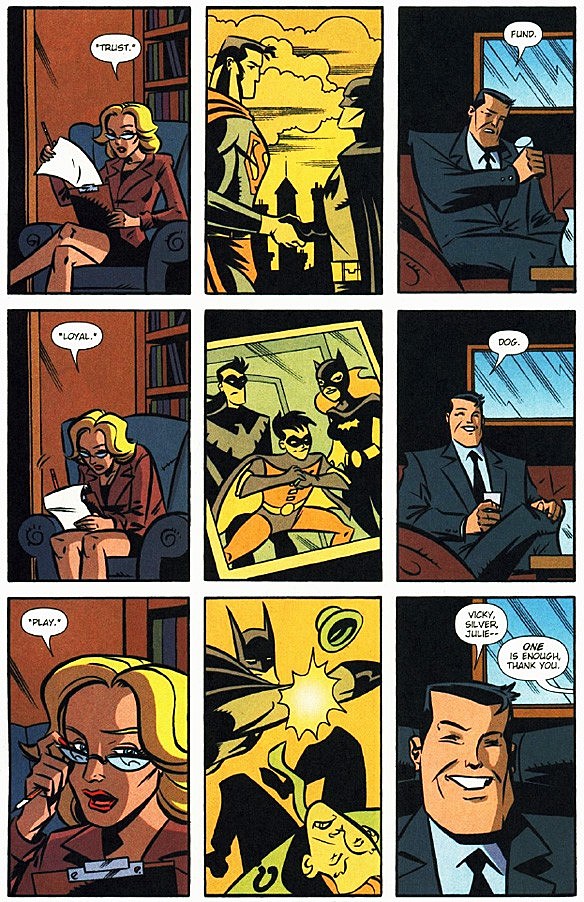
Batman's definition of "play" alone is worth the price of admission.
13. "The Doomsday Book" - Detective Comics #572 (1987)

It occurs to me that Mike W. Barr is the only writer to make it onto this list twice, and with good reason: His run might've had a few missteps, but when he hit, he knocked it out of the park as one of the best Batman writers of all time.
This one's a great example of that. Released to celebrate the 50th anniversary of Detective Comics, this is an adventure where Batman, the Elongated Man and Slam Bradley team up with Sherlock Holmes to stop Moriarty's great-grandnephew from blowing up the Queen of England.

One more time: Batman teams up with Sherlock Holmes. Further discussion should not be necessary.
12. The Untold Legend of the Batman #1 - 3 (1980)

At this point in the article, it's probably pretty clear that I'm something of a Batman fan, and a lot of that has to do with the fact that I had a copy of Untold Legend when I was a kid. It's essentially a three-issue crash course in Batman history disguised as a story, and I absolutely loved it. Admittedly, my love for it also springs from the fact that my copy with an audiobook adaptation on cassette tape, but the point stands.
In order to provide Batman with a reason for him to talk about his past -- which, this being the Silver Age version, included Bruce Wayne being the original Robin and a recap of the story where he tracked down the man who killed his parents, revealed his identity, and sent him running into traffic -- writer Len Wein came up with a compelling story that reads like the Cliffs Notes version of Batman R.I.P.: Someone who knows everything about Batman is trying to destroy him piece by piece, starting by burning the "original Batman costume" worn to a Halloween party by Thomas Wayne.
This upsets Batman, and he starts straight up slapping men in the face.

It gets even better when it's revealed at the end -- and Spoiler Warning, but c'mon, this thing is 31 years old -- that Batman's actually doing it all to himself having suffered a head injury leading to a psychotic break when Catwoman exploded a warehouse at him.
Thus it is proven: The only person who can destroy Batman... is Batman.
11: Batman Adventures #3 (1992)
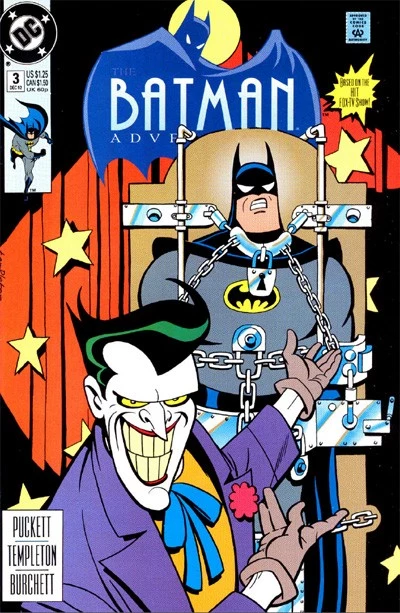
It's pretty common knowledge that Batman: The Animated Series is one of the best depictions of the character outside of comics -- and that would be because it's completely true -- but even dedicated fans of the cartoon often overlook just how good its comic book companion was. Written by Kelly Puckett with regular artist Mike Parobeck and fill-ins from incredibly talented guys like Ty Templeton and Rick Burchett, The Batman Adventures was a master class in how to create tight, compelling plots that played out in 22-page stories that weren't just good for an all-ages book, they were quite easily the best Batman comics of the '90s.
depictions of the character outside of comics -- and that would be because it's completely true -- but even dedicated fans of the cartoon often overlook just how good its comic book companion was. Written by Kelly Puckett with regular artist Mike Parobeck and fill-ins from incredibly talented guys like Ty Templeton and Rick Burchett, The Batman Adventures was a master class in how to create tight, compelling plots that played out in 22-page stories that weren't just good for an all-ages book, they were quite easily the best Batman comics of the '90s.
The whole run's worth checking out -- #10 is one of the best Riddler stories of all time, right after "Dark Knight, Dark City" -- but it's the first three issues that sold me on this one back when I was a kid buying comics at the Piggly Wiggly. Each issue is self-contained, but there's an arc going through those first three that the Joker is manipulating other villains in preparation for something big, while at the same time hitting on what made these characters what they were, like the Penguin's aspirations to upper-class crime.
#3, though, is where it really comes to a head, as the Joker reveals his master plan, and no joke: It is essentially the template for Christopher Nolan's version of the Joker from The Dark Knight.
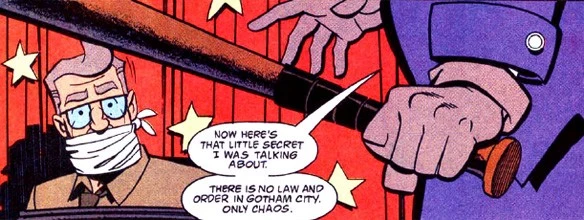
He wants to undermine the very idea of law in Gotham City and then unmask Batman as his final, humiliating defeat.
I remember reading this when I was 10 and being legitimately scared of the Joker for the first time in my life. I'd gone from watching Batman '66 for an hour every day after school to reading this story -- which again, was in a book for kids based on a cartoon -- where the Joker ties up Jim Gordon and breaks his arms with a baseball bat on live television while Batman watches, his face not showing any emotion other than grim resolve.

I've read the story a hundred times since then, and even without the lens of nostalgia, it holds up. That close-up of the Joker's face by Templeton and Burchett is still my favorite picture of the character, and everything you need to know about him is laid out for you in that one violent, terrifying sequence.
And that's just one page.
That's all we have for this week, but if you've got a question you'd like to see Chris tackle in a future column, just put it on Twitter with the hashtag #AskChris, or send an email to comicsalliance@gmail.com with [Ask Chris] in the subject line!
More From ComicsAlliance









